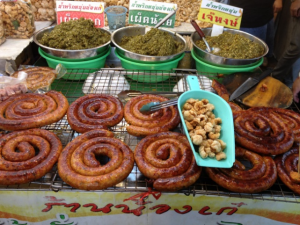
Northern Thai cuisine, also known as lanna or ahan nure, is a mixing pot of foreign influences and regional specialties. Culinary traditions from southern China and Indian spices are matched with local meats and produce, creating intense flavors found only in this small refuge of Asia. Pungent aromas, wild herbs, and a sharp, lingering spiciness are key features of this mysterious cuisine.
The immigrants who settled in northern Thailand hailed from Yunnan and Guangxi, provinces of southern China. They established the Lanna Kingdom (or, “Kingdom of a Million Rice Fields”) in this rainy, mountainous region. The fertile soil supported acres of rice paddies, as well as the seeds they brought from their homeland. Access to the Mekong river gave them freshwater fish and crabs, and the Thai still hunt along its distributaries.
Northern Thai cuisine rarely uses “soupy” curry or coconut milk. Isolation in the mountains meant seafood was a luxury, and although fish sauce is now common in Northern Thai dishes, it is not a defining ingredient. Instead, saltiness is derived from rice-paddy crabs and the offal. Durians, Asian bananas, and papayas brought sweetness, and bird’s eye chili gave dishes a powerful kick. A willingness to use unique (if off-putting) ingredients, and an open mind to other food cultures, is what best characterizes Northern Thai food.
